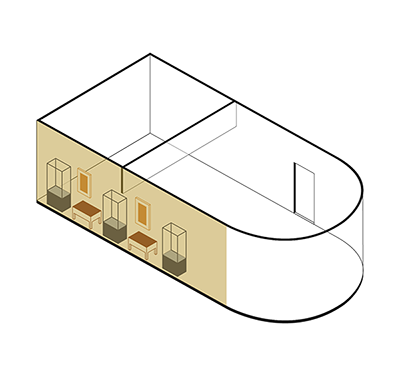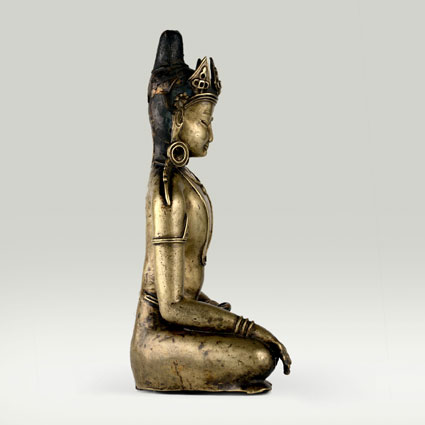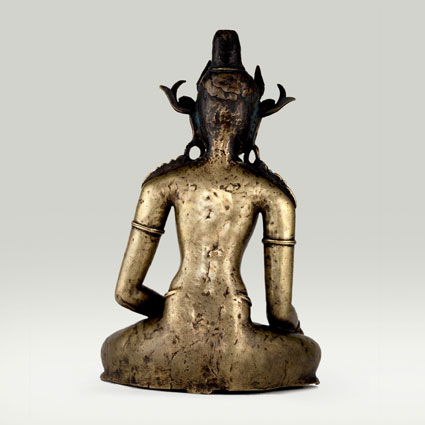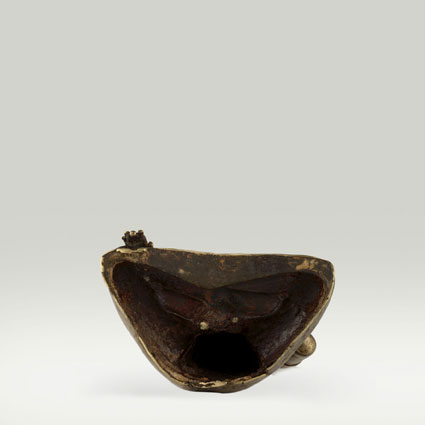
ABS 203
Code: ABS 203
Country: Tibet (west)
Style:
Date: 1100 - 1200
Dimensions in cm WxHxD: 15.9 x 25.3 x 9.4
Materials: Brass
Height: 25.3 cm
This statue of Akœobhya was likely cast by a Tibetan artist. Rendered in a Tibetan style, it is echoing influences from both North-Eastern Indian and Nepalese art.
The essential nature of a bodhisattva or a buddha is that he or she embraces the enlightened qualities of the five buddha families, which pervade every living being without exception, including ourselves.
To achieve the realization of these five buddha families or the five dhyana buddhas, it is necessary to abandon the five disturbing emotions of great attachment, anger or aggression, ignorance or bewilderment, pride and envy. When these disturbing emotions are purified and removed, the five wisdoms shine forth. Realization of the five wisdoms is realization of the five dhyana buddhas. To begin with, we have to understand what the five disturbing emotions (Skt. kleshas) are.
1. The first, which seems to be most powerful, is anger. Anger is an emotion which arises and develops against someone or something one dislikes. If examined carefully, in the short run anger creates pain and in the long run it brings about serious harm. The immediate pain and future harm is to oneself as well as to others is due to the power of one’s own aggression. We therefore need to understand the first negative emotion. The negative emotion of anger causes temporary suffering for oneself and others for this lifetime. This emotion is so powerful that all negative actions or karma accumulated by wishing harm to others can lead one to take rebirth in the lower realms. For example, intense anger can cause rebirth in the lowest hell realm where there is intense suffering. Therefore, anger not only causes suffering and pain in this lifetime, but also causes us to take birth in the lower realms, where even more intense suffering ensues as a result. To be free of the experience of suffering and pain in this lifetime and to be free of the experience of taking birth in a lower realm, it is necessary to employ methods to overcome and eliminate anger and hatred.
When anger is purified and removed, we come to develop and to gradually realize mirror-like wisdom. With mirror-like The Five Buddha Families and the Eight Consciousnesses wisdom, there is no distinction between self and others, there is no separation between self and other phenomena, so everything is experienced in unity and harmony. It is called mirror-like wisdom because phenomena appear to the mind in the same way that things appear in a clean mirror, completely accurate with no distortion. Understanding and realizing mirror-like wisdom takes place in the absence of the negative emotion of anger. Realization of mirror-like wisdom is realization of Buddha Akshobhya, who is blue in color. He holds a vajra in his left hand. His activity is pacifying the emotions, in particular, suffering, illness, frustration, and sorrow.
2. The second dhyana Buddha is the Buddha Ratnasambhava who is realized when the disturbing emotion of pride or ego is purified. Ego is the belief in a self which we all develop from birth as soon as our mind thinks of itself as separate from others. The next three types of pride evolve in this process of selfcenteredness: (1) We feel that we are better than others who are in a less fortunate situation, (2) we feel that we are superior to others because we fail to see the equality of ourself and others; and (3) we feel we are either spiritually or materially better than others. What causes us to embark upon the journey of ego? When the self believes that it is separate from others, the negative emotion of pride arises in which one believes oneself in some way better than others. From this then arises the belief that there are “good” i.e. things which we believe in and do and “bad” i.e. things that others believe in and do. As long as we believe ourselves to be superior to others, it is impossible to learn from them. So we must give up ego clinging to develop enlightened qualities. A purified mind does not distinguish between pure and impure, good and bad, I and others; rather it experiences all things in equality. When one is free from pride, realization of the wisdom of equality dawns and one experiences and becomes Buddha Ratnasambhava.
Buddha Ratnasambhava’s activity is enriching and as a symbol of his activity of enrichment, he is gold or yellow in color. As a symbol of his ability to enrich all living beings, he holds the precious wish-fulfilling jewel in his hands.
3. The third dhyana Buddha represents the purification and elimination of the disturbing emotion of attachment or desire. Desire causes much suffering by being quite distracting and keeping the mind restless and busy. Why? When one is attached to things, one is never satisfied and always craves for more and better things. One is continuously engaged in achieving and acquiring the mind’s desires and only experiences loss and dissatisfaction in one’s life. By understanding this negative emotion and by eliminating it, the third discerning wisdom shines forth. By realizing discerning wisdom, the enlightened mind is experienced, and one becomes one with the Buddha Amitabha. It is with this wisdom that one understands and has empathy with each and every living being and appreciates others’ qualities.
The Buddha Amitabha’s nature is the absence of attachment and desire and his activity is magnetizing. As already said, attachment and desire lead to the suffering of dissatisfaction, a state in which one always wants and strives for more and better things. Desire determines one’s behavior and not attaining what one desires leads to frustration and dissatisfaction. With the discerning wisdom and the realization of Buddha Amitabha, there is no attachment and desire and thus no dissatisfaction or craving for more and better things. This realization is so powerful that all things are naturally magnetized as one’s own. There is no energy and force involved as in a state of desire.
4. The fourth dhyana Buddha is Buddha Amogasiddha. He is realized in the absence of the negative emotion of jealousy which includes being jealous of others’ wealth, success, and good fortune. With jealousy negativity is accumulated. By overcoming jealousy, Amogasiddha and the fourth all accomplishing wisdom are realized. Jealousy prevents and impedes an individual from accomplishing his or her own well-being and as a result he or she experiences more suffering and continues developing further jealousy towards those who have more. This is the reason all accomplishing wisdom is experienced in the absence of jealousy, i.e., when jealousy is removed, all wishes are naturally and effortlessly accomplished. As long as jealousy determines one’s attitude, one is bound to experience more obstacles in achieving personal success and in accomplishing positive goals.
This is why Buddha Amogasiddha’s activity is wrathful. It is with wrath that he removes all obstacles and hindrances preventing spiritual maturation and success. He is green in color, the same color as growing plants symbolizing the numerous activities he employs to remove hindrances.
5. The fifth dhyana Buddha is Buddha Vairocana, who is realized when the negative emotion of ignorance is overcome. Ignorance is failing to recognize what is wholesome and unwholesome, failing to know the ultimate and conventional truth and failing to realize the highest state of dharmata. Ignorance is the root of the negative emotions, so that, for example, it is only out of ignorance that one is angry. One only acts aggressively towards others because one is ignorant that anger will only bring on pain and sorrow to oneself and others. Likewise, it is only due to ignorance that one has pride, desire, and jealousy.
Elimination of the darkness of ignorance is the realization of Buddha Vairocana. The wisdom which shines forth when ignorance is overcome is the wisdom of dharmata, i.e., realization of the highest state. We have failed to realize the true state up until now due to ignorance, and this ignorance causes all the mental confusion and misleading actions. Purification of ignorance engenders realization of the wisdom which sees all things as they really are. The natural body of the purity of the wisdom of dharmata is Buddha Vairocana. Since the darkness of ignorance is eliminated, he is the clear color of white.
Qualities Arising from Transforming Negative Emotions
We have given a brief description of the five dhyana buddhas who represent the purified qualities of the five disturbing emotions. When these five negative emotions are purified, the qualities of the five buddhas shine forth purely.
In Vajrayana Buddhism, Akshobhya (Sanskrit: "Immovable One") is one of the Five Wisdom Buddhas, a product of the Adibuddha, who represents consciousness as an aspect of reality. By convention he is located in the east of the Diamond Realm and is the lord of the Eastern Pure Land Abhirati ('The Joyous'), although the Pure Land of Akshobhya's western counterpart Amitabha is far better known. His consort is Locana and he is normally accompanied by two elephants. His color is blue, and his attributes include the bell, three robes, and staff, along with a jewel, lotus, prayer wheel, and sword. He has several emanations.
Origin
Akshobhya appears in the "Scripture of the Buddha-land of Akshobhya", which dates from 147 CE and is the oldest known Pure Land text. According to the scripture, a monk wished to practice the Dharma in the eastern world of delight and made a vow to think no anger or malice towards any being until enlightenment. He duly proved "immovable" and when he succeeded, he became the buddha Akshobhya.
Akshobhya is sometimes merged with Acala, whose name also means 'immovable one' in Sanskrit. However, Acala is not a buddha, but one of the Five Wisdom Kings of the Womb Realm in Vajrayana.
Prior to the advent of Bhaisajyaguru (Yakushi), Akshobhya was the subject of a minor cult in Japan as a healing buddha, though even now both are found within the Shingon school of Buddhism in Japan.
Recently, newly discovered Gandhari texts from Pakistan in the Bajaur Collection has been found to contain fragments of an early Mahayan sutra mentioning Aksobhya. Preliminary dating through paleography suggests a late first century to early second century CE provenance. More conclusive radiocarbon dating is underway. A complete analysis and report of the text is expected in late 2008.
Akshobhya is believed to transform the human failing of anger into a clear, mirror-like wisdom. With this wisdom, we see things just as they are, impartially and unaffectedly. A mirror will reflect both a red rose or a bloody dagger just as they are.
Akshobhya’s blue color is closely linked to the mirror symbolism. Blue is the color of water, and water has the capacity to act as a clear mirror.
Iconography
Akshobhya makes the bhumisparsha mudra (earth touching gesture). This mudra suggests confidence, deep-rootedness, and the same kind of determination which carried the Buddha to his enlightenment, in spite of the numerous hurdles that stood in his path.
Akshobhya’s emblem is the vajra, the symbol of Vajrayana, or tantric Buddhism. The vajra essentially symbolizes the essential qualities of enlightenment - the strength, power, and energy of the thunderbolt, and the brilliance, purity, and indestructibility of a diamond. That is why Akshobhya is depicted touching the earth with the fingertips of his right hand, just as Shakyamuni Buddha did when Mara "the evil One" confronted him at the Bodhi tree and tried to prevent him from reaching his goal of enlightenment. Touching the earth is a gesture of resolve. A vow to be as steadfast and immutable as the Earth itself. A commitment to find enlightenment and help eliminate the suffering of all beings.
Akshobhya’s mount is the elephant. An elephant places its foot upon the earth with unshakeable certainty. It has the same unalterable quality as the Buddha’s fingers touching the ground, and the same determination that carried the Buddha through his tribulations.
Akshobhya is the embodiment of mirror knowledge. A knowledge of what is real, and what is illusion, or a mere reflection of actual reality. The mirror is mind itself - clear like the sky, empty yet luminous. Holding all the images of space and time, yet untouched by them. He represents the eternal mind, and the Vajra family is connected with reason and intellect. Its brilliance illuminates the darkness of ignorance, it's sharpness cuts through confusion.
The Vajra family, to which Akshobhya belongs, is associated with the element of water. This is why the two colors of Vajra are blue or white. Bright white like sun reflecting off water, and blue, like the depths of the ocean. Even if the surface of the ocean is blown into crashing waves, the depths remain undisturbed, imperturbable. And though water may seem ethereal and weightless, in truth it is extremely heavy. Water flows into the lowest place and settles there. It carves through solid rock, but calmly, without violence. When frozen, it is hard, sharp, and clear like the intellect, but to reach it's full potential, it must also be fluid and adaptable like a flowing river. These are all the essential qualities of Akshobhya.
Many wrathful tantric beings are represented as blue in color because they embody the transmuted energy of hatred and aggression, into wisdom and enlightenment.
Buddha Akshobhya
The disturbing emotion of anger is transformed into the Buddha Akshobhya’s wisdom at enlightenment and we may ask how aggression or anger relates to Buddha Akshobhya, who is a very peaceful activity. Or we may wonder how the absence of anger is Buddha Akshobhya. It is important to know that Akshobhya is the Sanskrit name and in Tibetan he is called sangay mikyodpa or the “immovable, stable and changeless Buddha.” He is called “immovable and changeless” because when the disturbing emotion of anger is present, everything inevitably changes; our
face becomes red, the body begins to shake and the friend we are angry with becomes our enemy. When anger is purified, everything is peaceful and stable which is the realization of the meaning of the changeless, stable, and permanent Buddha Akshobhya. The Buddha Akshobhya’s blue color has a symbolical meaning. The dhyana buddhas are of the five main colors of blue, red, yellow, green and white. Blue symbolizes permanence
that is changeless just as the sky has always been blue, whether this year or a thousand years ago. The Buddha Akshobhya is blue to represent this changelessness. Furthermore, the buddha Akshobhya also holds a vajra in his lap which is also a symbol of his indestructible and changeless nature. He sits in the full vajra or full lotus posture to symbolize the indestructible nature and his right hand touches the earth which is also a gesture of the changeless. In a mandala Akshobhya resides in the east and is painted as being on an elephant throne. Incidentally, in a mandala the position away from one is always west regardless of what the real direction is.
Béguin, Gilles, 2013. Art sacré du Tibet – Collection Alain Bordier, [catalogue of the exhibition held at the Fondation Pierre Bergé – Yves Saint Laurent; 14 mars au 21 juillet 2013]. Paris: Fondation Pierre Bergé – Yves Saint Laurent. Editions Findakli. Pp. 163 -164
Bock, Etienne; Falcombello, Jean-Marc; Jenny Magali, 2022. Trésors du Tibet. Sur les pas de Milarépa.. Paris: Flammarion. P. 163
Khenchen Thrangu, 1998. The Five Buddha Families and the Eight Consciousnesses. Boulder: Namo Buddha Seminar . Namo Buddha Seminar 1390 Kalmia Avenue Boulder, CO, 80304-1318 USA Tel.: (303) 449-6608 Email: cjohnson@ix.netcom.com Rinpoche’s web site: www.rinpoche.com
Midal, Fabrice, 2000. Mythes et dieux tibétains. Une entrée dans le monde sacré.. Edition du Seuil.
Sèngué, Tcheuky, 2002. Petite Encyclopédie des Divinités et symboles du Bouddhisme Tibétain. Editions Claire Lumiere . Pp. 1120-121
von Schroeder, Ulrich, 2010. Buddhist Sculptures of the Alain Bordier Foundation. Hong Kong: Visual Dharma Publications, Ltd.. Pp. 40–41; plate 17A
von Schroeder, Ulrich, 1981. Indo-Tibetan Bronzes. Hong Kong: Visual Dharma Publications, Ltd.. Pp. 178–179, plate 33B





